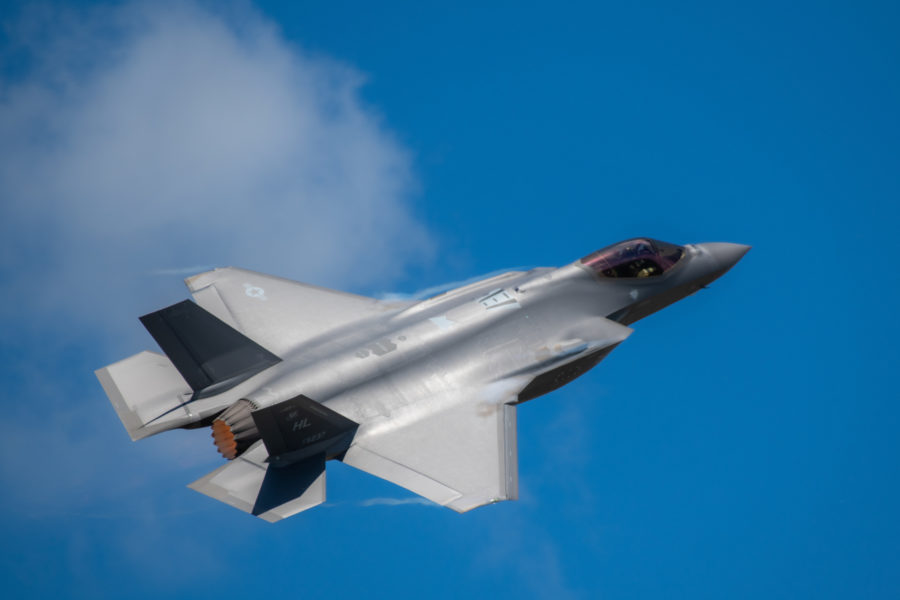Lockheed Martin suggested the long-term sales prospects for its F-35 jet are uncertain amid worries the Department of Defense may begin to pivot away from the program. In the short term, new production of the F-35 will go down in 2023.
“The U.S. government’s got to kind of determine what its budget priorities are at the macro level going forward,” Lockheed Martin CEO James D. Taiclet said on a quarterly earnings call Oct. 17.
Much of the U.S. military’s focus is shifting towards strategic deterrence, Taiclet claimed—that means more of the defense budget will be spent on new Air Force programs such as the B-21 stealth bomber and the LGM-35A Sentinel intercontinental ballistic missile that will replace the Minuteman III.
“There’s going to be a significant amount of defense budget proportionally spent on the nuclear revitalization,” Taiclet said. However, Lockheed Martin’s boss said that should not come at the expense of tactical aircraft.
“The conventional threats have gotten worse instead of better,” Taiclet said. “As we look forward into the next two or three or four years, that’s going to be a budget issue for the U.S. government.”
The company put its short-term decreased F-35 production down to supply-chain issues and the need to fill outstanding orders.
“There will be a period of catch-up,” Chief Financial Officer Jay Malave said of the F-35. “Production will be down next year.” Malave said the company expected supply chain issues and other “headwinds” facing the program will “normalize heading into 2024.”
The company expects a Lot 16 F-35 order worth more than $8 billion to be completed by the end of 2022. In August, the Pentagon awarded a $7.6 billion Lot 15 contract to Lockheed Martin for up to 129 aircraft with 49 F-35As bound for the Air Force.
In the future, Lockheed Martin sees strong demand for the F-35 abroad but some tepidness for the plane at home. In light of Russia’s aggression, European militaries have bolstered their defense spending, including F-35s. In September, the Swiss government signed a contract for 36 F-35As—Denmark, Israel, Italy, the Netherlands, Norway, and the U.K all already operate the fighter, and Belgium, Finland, Germany, and Poland have all officially selected it. Greece and the Czech Republic are also seeking to buy.
The DOD, however, has been less keen on new aircraft purchases. The Air Force requested just 33 F-35As in its 2023 budget, which has yet to be passed by Congress.
Lockheed has set a long-term objective to produce 156 F-35s a year.
“It takes about 80 U.S. aircraft to make that happen per year with another 75 or so coming from international,” Taiclet said. “We see the international demand. It’s going to be up to the U.S. government to try to support that number.”
Some U.S. uncertainty stems from outstanding issues regarding what capabilities future F-35s will have, not just budget concerns.
The services are awaiting Lockheed Martin’s long-planned Block 4 and Technical Refresh 3 improvements to the jet and DOD’s own decision on the powerplant for Block 4 fighters. If a newly-designed, more expensive option from the Adaptive Engine Transition Program is chosen, Air Force Secretary Frank Kendall has suggested the service will be forced to buy fewer F-35As.
Lockheed’s executives acknowledged that America’s yearly F-35 buys would result from not just the DOD’s future budget priorities but what Congress ultimately decides to put into law. In the case of the Pentagon’s fiscal 2023 budget, that hasn’t happened yet.
“The defense budget is expected to go above and beyond what the President’s original submission was,” Taiclet said, adding the final bill “probably would benefit” the F-35.
For now, Lockheed Martin’s goal of 156 F-35s per year still stands.
“We hope for that,” Taiclet said. “We expect it because that’s the need, and that’s where we think the F-35 program is going to go.”

